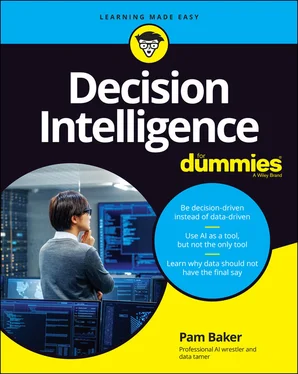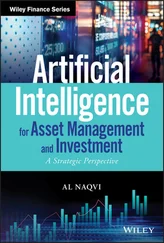1 ...6 7 8 10 11 12 ...17 The bottom line here is that monetary costs should be relatively small. You may need to spend more on training, however, because your tech people may need additional training on decision theory and the decision sciences — as well as on decision intelligence tactics. Conversely, your business leaders may need that training, too, as well as some training on BI apps to gain a working understanding of data analysis and its full potential.
Chapter 2
Mining Data versus Minding the Answer
IN THIS CHAPTER
 Distinguishing between data driven targeting and decision targeting
Distinguishing between data driven targeting and decision targeting
 Dealing with the fact that data may give you answers but still no one knows what to do
Dealing with the fact that data may give you answers but still no one knows what to do
 Reimagining actionable outcomes
Reimagining actionable outcomes
Data driven decisioning is evolving beyond mere data discovery to results-based decision targeting. This newest step on the data science evolutionary chain is known as decision intelligence (DI), a discipline that combines data science, social science, and managerial science into a singularly focused approach to making the best decision possible in any given circumstance.
In this chapter, you find out why targeting an outcome at the outset trumps the traditional model of mining the data first. The result becomes the prime directive in this 180-degree turn in the definition and execution of the oft-sought actionable outcome.
In other words, the focus shifting from discovering information within established data sets to deciding what you most need to know and then actively searching for that knowledge wherever it may reside.
In short, data takes a supporting role rather than a starring role in decision intelligence. The human mind also moves from a role as data/analytics organizer to that of a high-value player in search of the best decision possible. And, last but not least, artificial intelligence (AI) becomes a helpful assistant rather than a dreaded human overlord or job slayer.
In this chapter, you see why this rethinking on how to use data spawned a rising transformative and disruptive force in business as well as in people’s daily lives. You also see why you should be quick to wield this force in any job role you may decide to take on over the course of your career.
Knowledge Is Power — Data Is Just Information
In the beginning, there was data. From the ticking of fingers and toes to stones stored in crude pouches and sticks bundled in vine, the early humans collected and recorded information. This recording of information continued throughout time unabated. The media that was used to record that data changed over the years, according to the technologies of the time. Eventually, however, the data outgrew the number of devices set aside to collect and store it, as well as the number of people using those devices. That’s when we started calling it big data, in a nod toward its bigness overshadowing the capabilities of modern computing.
Folks tend to look in amazement at this growing trove of data, but the truth of the matter is that what seems like an immense resource is merely a mirror we humans are holding up to our world. And therein lies the problem: Possessing information that reflects the world back to us isn’t the same thing as being able to use that information in a practical, real-world sort of way — let alone to do so with any sort of consistent accuracy.
Putting it another way, decision intelligence arrived as a movement when it became evident that mining data is like mining for any other valuable substance: The value lies not in the crude form, but in the polished gem. The goal now is to identify the gem you seek and then go find it. The trick here is do so with the understanding that the work isn’t finished until you have achieved a high level of clarity in the decision-making process — a level of clarity seen only in the rarest of diamonds.
Experiencing the epiphany
To date, we humans have all been mining data to sort information into useful pointers — pointers to which products customers might want to buy now or next and which price they might be willing to pay, for example, or pointers on who on the team might have an edge to help win a baseball game or reach a sales quota, or even pointers on which activities might indicate the beginning of a data breach and which are the routine work behaviors of hundreds of staffers now working from home during a pandemic.
Pointers of all kinds — here, there and everywhere. And there’s nothing wrong with any of this. Pointers can, and often do, direct people to a path forward in business, at home, and in various other endeavors.
However, pointers mark a path (often, one among many), but they don’t decide which path you should take. In other words, pointers aren’t the same thing as decisions. You’re free to make the wrong choice as much as you’re free to make the right one. But that approach falls woefully short of the tall promise in data driven decisions, doesn’t it?
 “Following the data” was supposed to render some infallible truths and reliable actions. That’s why so many analytics vendors tout actionable outcomes or actionable outputs. Short of automating that action, however, even recommended actions are pointers as well.
“Following the data” was supposed to render some infallible truths and reliable actions. That’s why so many analytics vendors tout actionable outcomes or actionable outputs. Short of automating that action, however, even recommended actions are pointers as well.
For example, predictive analytics might produce an actionable outcome, saying that a part in a machine will last ten more days and should be replaced on the ninth day. This action gets the most use out of that part with no interruption in the machine’s performance. However, a decision still needs to be made. Company leaders may decide to order maintenance crews to follow all such directives and replace parts on the days indicated. Or, management may ignore the directive in favor of upgrading or replacing the machine instead.
That’s okay for as far as it goes. But you need more from data analytics if the aim is to make correct or best decisions of a more complex and demanding nature — especially if they are grave decisions that can carry serious consequences.
For example, take a hard look at the COVID-19 pandemic and the many survival questions that sprang forth from it. Data and analytics can tell us how the virus spread, which virus variations exist, and who was most at risk. This was and is important information. However, data and advanced analytics — even the much-ballyhooed AI — cannot tell us whether it’s safe to send children back to school. The information also shed no light on when, where, or how to safely return people to workspaces or to indoor dining and entertainment venues to help save the economy. In turn, leading public health authorities such as Dr. Fauci and others were unsure which actions to recommend.
In other words, all the data and all the analytics could not tell people what we most needed to know. And this is the recurring lesson that taught some data scientists to look for another way — perhaps by evolving current methods in analyzing data — so that outputs would consist of decisions and not mere information. In the wake of recognizing that today’s data idol has feet of clay, we have come to this powerful epiphany:
Information is useful, but knowledge is power.
If you’re thinking that we humans are rediscovering an epiphany first perceived many years ago, you are correct. Similarly, decision intelligence is not a new idea but rather a renewed one.
Читать дальше

 Distinguishing between data driven targeting and decision targeting
Distinguishing between data driven targeting and decision targeting “Following the data” was supposed to render some infallible truths and reliable actions. That’s why so many analytics vendors tout actionable outcomes or actionable outputs. Short of automating that action, however, even recommended actions are pointers as well.
“Following the data” was supposed to render some infallible truths and reliable actions. That’s why so many analytics vendors tout actionable outcomes or actionable outputs. Short of automating that action, however, even recommended actions are pointers as well.










